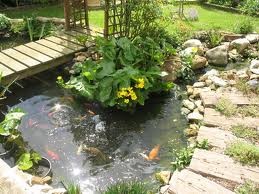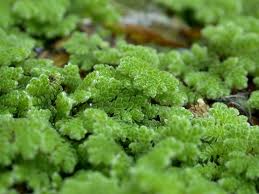





The aesthetics of a water garden are largely determined by the configuration of the open water area, whether this is intended to complement the planting or is the main reason for the pool’s construction.
Plants are also important in providing colour, form and height. Put these together and the overall effect of the water feature is achieved.
Fish are as much a part of a water garden as plants, although some gardeners do not rate them highly. It is true that a well planted garden pool will not be ideal for a fish fancier who wants to practise selective breeding, but it will be a pleasant haven for a modest selection of decorative fish that will live and breed happily with little attention.
 Even though some gardeners have no intention of becoming fish fanciers, introducing fish to a water feature is worthwhile. Not only do they add life to the pool, but they also act as a fine biological control of most aquatic insect pests.
Even though some gardeners have no intention of becoming fish fanciers, introducing fish to a water feature is worthwhile. Not only do they add life to the pool, but they also act as a fine biological control of most aquatic insect pests.
Common goldfish and shubunkins, golden orfe and green tench are all quite resilient. They will survive the winter in as little as 30cm (12in) of water, although 45cm (18in) is preferable. This will also protect any fancy goldfish, such as fantails and moors, which would be at risk in shallower water. However, it is not only the depth of water that is critical; the surface area must be as large as possible to permit gaseous exchange.
A well planted pool generally provides sufficient cover for ornamental fish, especially when submerged aquatics are liberally introduced. Although fish enjoy basking in the sunshine, in really hot weather, they require some respite, and submerged and floating foliage can offer this. Such plants also give some protection from predatory cats and herons, but only during the active growing season; in the winter, the pool will be bare and the fish exposed. To protect fish when the pool is devoid of foliage, a few rocks should be placed on the floor of the pool so that the fish can shelter beneath them. This will not interfere with any planting in the pool.
Such shelters are available to buy ready-made for small water gardens.
Apart from the generous introduction of submerged aquatics, the positioning of marginal plants is also quite important. As far as possible, make sure that the entire marginal shelf is planted. Any vacant spots will be quickly spotted by birds and used as bathing places, often with disastrous results. In country areas, birds often bring pesticides with them on their feathers; even a small trace of such chemicals can kill fish. If birds are permitted to bathe freely, this becomes a very real threat. To counter this, provide them with their own separate bird bath and make sure the margins are full.
Whether your pool is a deliberate wildlife feature, or merely attracts wildlife in the way that pools inevitably do, some consideration should be given to their presence. A pool will often be the watering hole of many small animals, including hedgehogs. If its margins are heavily planted to exclude birds, there is a great danger that deeper areas will be used for drinking with the attendant risk of some of these animals taking a tumble and drowning.
Hedgehogs and other small mammals can usually swim for a short time, so if an escape route is provided, such tragic accidents are less likely to occur. Some pre-formed pools incorporate a small ramp to allow escape, but a similar feature is quite easy to install in any pool. A simple narrow board with small wooden cross-pieces would be perfectly adequate.
The design of a water feature should not only be pleasing to the eye, but also embrace all the requirements of aquatic life. Plants must be happy in the home that you have provided and, equally important, must be easy to maintain. Pest and disease control and feeding regimes should be borne in mind, too. However, the most important design element, from the practical growing and management point of view, is the profile of the pond structure. There are four groups of plants to consider, each of which has its own specific requirements.
The waterlilies and other deep-water aquatics, such as the water hawthorn, require deeper water than the marginal plants. However, this rarely need be more than 90cm (36in), for all the popular waterlilies will grow successfully in this depth of water. This is also the maximum depth at which other desirable deep-water aquatics will be happy. A garden pool does not depend upon a great depth of water for its success, but rather the balance of a sensible depth with a generous surface area.
If practical reasons dictate a shallower pool, there are many waterlily varieties that can be grown successfully in much less water; some pygmy waterlilies will even flourish in as little at 15cm (6in) of water. In fact, the majority of desirable deep-water subjects will also adapt to shallower conditions. But bear in mind the well-being of any fish before settling on a shallow depth.
Submerged aquatics must have sufficient depth in which to remain submerged in a water temperature that does not become too high during summer. Most popular submerged aquatics are happiest growing in 45-90cm (18-36in) of water. Beyond that depth, the water becomes dark and gloomy, impairing growth, while shallower water can heat up and cause dense submerged growth to decompose.
Most submerged plants naturally flower at, or just above, the surface of the water and, with few exceptions, they will grow to a length dictated by the water’s depth. Provided this is within the guidelines given, the majority should develop successfully. Only the likes of the consistently short growing hair grass (Eleocharis acicularis) will be adversely affected by excessively deep water or very shallow conditions. Conversely, there are rootless submerged aquatics, like the hornwort (Ceratophyllum demersum), that suspend themselves in the water at the most advantageous position, irrespective of depth.
 Floating plants are not too bothered by depth, although shallow water can pose problems by heating up during the summer. Some of the smaller floaters, such as the frogbit (Hydrocharis morsus-ranae) resent warm water and may rot; on the other hand, fairy moss (Azolla caroliniana) would not object. So if circumstances force particular conditions upon you, you will need to select plants carefully to avoid problems.
Floating plants are not too bothered by depth, although shallow water can pose problems by heating up during the summer. Some of the smaller floaters, such as the frogbit (Hydrocharis morsus-ranae) resent warm water and may rot; on the other hand, fairy moss (Azolla caroliniana) would not object. So if circumstances force particular conditions upon you, you will need to select plants carefully to avoid problems.
Although deep water does not have any adverse effect upon floating plants, it will be colder in spring than shallower water, which will impair the re-appearance of the overwintering plants. With few exceptions, floating aquatics produce winter buds, or turions, which spend the winter on the floor of the pool. As soon as spring sun warms the water, they come to life and start to grow. Cold deep water obviously slows this process, and they may be two or three weeks later in coming to the surface.
The marginal area of a pool provides the best opportunity for growing interesting aquatic plants. It can be of varying depth, as most marginal plants are natural stream or riverside dwellers and are used to periodic drying and inundation. Consequently, they will grow in merely damp conditions or several centimetres of water. A generous marginal shelf that will accommodate a standard planting basket, both in width and depth, and permit 5cm (2in) of water over the top of the basket is ideal.
The way in which the margins are distributed around the pool is purely a matter of taste, but they should be as long as possible if they are to co-ordinate visually as a whole. Short lengths of marginal shelf, sufficient to take a couple of baskets, look untidy. They really only have a place in a formal pool. Where architectural plants such as reeds or rushes are desired in the corners or spaced along its edge.
A bog garden will be a valuable addition to most pools for, except in very formal circumstances, it will tie the feature visually to the surrounding garden. It will also offer great opportunities for growing a wide range of interesting plants that would be difficult to accommodate in other parts of the garden. Consider the bog garden from the beginning Do not construct the pool, then decide that a bog garden would be a pleasant feature, for it will be much more difficult to add. A bog garden should be a natural extension of the pool. Particularly if you are planning to build a pool using a flexible liner, a bog garden can be accommodated quite easily and effectively.
However carefully you construct and plant your pool, it will always be potentially dangerous, especially for children. While a child can drown in very shallow water, you will reduce many of the risks by making the maximum depth not more than 90cm (36in). Planting around the edge, together with the use of shallow margins and bog garden extensions, also reduces the chances of an accident through some one slipping into the water.
Obviously, the edge of the pool produces the greatest hazard, so any edging materials should be chosen with care. Paving should be sufficiently wide to accommodate a foot and, as far as is practicable, have a non-slip surface. Where visitors may be encouraged to stand to look at fish, make sure that the paving is not only secured firmly, but also that there are no gaps into which a woman’s high-heeled shoe may become wedged.
Electricity can also pose a danger, so use only the recommended armoured waterproof cable when installing a pump in the pool. The latter will require removing from the pool during the winter and, if you have fish in the pool, you may want to replace it with a pool heater, so a connection close by is essential. This should be safely housed beneath a paving slab that can be removed rather like a manhole cover. All electricity supplied to the pool should be connected via an RCD circuit breaker.
Copyright © www.100flowers.win Botanic Garden All Rights Reserved